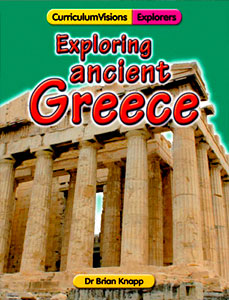All of the countries of the Mediterranean had galleys, ships which relied for their speed on banks of oarsmen. The sails were not used in battle. The biggest of these – perhaps 75m long – had three banks of oars and were called triremes (tri means three). They carried about 200 people, the great majority of whom were oarsmen. Each boat carried a small number of soldiers for hand to hand fighting when ships came close together.
The Greeks, and especially the Athenians (who were the main seagoing city in Greece) were proud of their ships. But the Persians had by far the biggest fleet in the Mediterranean. They also had the biggest and fastest boats.
The Battle of Salamis is a ‘David and Goliath’ story. Here the Greeks are tiny David, and the Persians under King Xerxes are gigantic Goliath. The Greeks were outnumbered in ships by three to one and so if they were to win, it had to be through cunning – and the overconfidence of the Persians.
This is what happened. The Persians had sailed over the Aegean Sea and burned the city of Athens. In fear of their lives, the Athenians had fled to the island of Salamis. The Greek fleet tried to beat the Persians, but it was a standoff and so they, too, retreated to Salamis.
Meanwhile, the Spartans wanted to go back to Sparta, where they thought they stood a better chance of keeping the Persians at bay. But the Athenian commander, Themistocles, persuaded them to remain at Salamis. He was able to do this because of the prophecy by the oracle at Delphi which said that Salamis would “bring death to women’s sons,” but also that the Greeks would be saved by a “wooden wall”. Themistocles said that the wooden wall was a fleet of ships, and Salamis would bring death to the Persians, not the Greeks.
King Xerxes expected an easy victory. Xerxes knew that the Greek navy was hiding at Salamis. Themistocles sent out a slave who pretended he had run away from the Greeks. He told Xerxes that the Greeks could not decide what to do and the navy was about to flee. Xerxes wanted to crush the Greek navy once and for all, and so he sent his navy looking for them. They looked all night and were exhausted. But they found no ships because Themistocles had his ships still in harbour waiting.
The next morning the Persians sailed in to the straits to attack the Greek fleet. Part of the Greek fleet then pretended to retreat, luring the Persians farther into the narrow straits.
Then the Greeks attacked. The much larger Persian fleet could not turn in the straits. The Persians tried to turn back, but there were now too many of them jammed into the straits. The Greek and Persian ships rammed each other.
At least 200 Persian ships were sunk. But the Persians could not swim, so as each boat sank, the men drowned.
Because the Battle of Salamis saved Greece from becoming part of the Persian empire, it meant that the Persians never conquered Europe. Many historians have therefore called the Battle of Salamis one of the most important battles of all time.
There are pictures of the battle scene in the Ancient Greeks book (see below).





